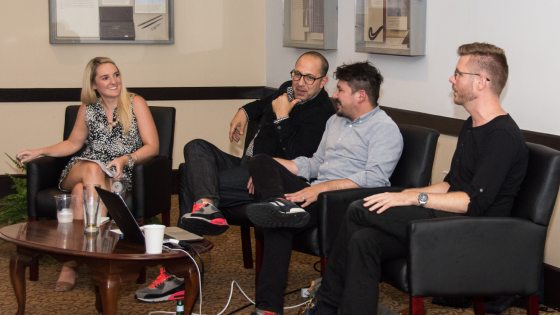The final installment of the Nightscape Artist & Friends Speaker Series took place last Friday with a new set of panelists. Navid Khonsari and Torfi Frans Olafsson shared stories about their professional backgrounds with Ricardo Rivera, the director of Nightscape and founding partner of Klip Collective. Khonsari is the Executive Producer of iNK Stories, an independent media studio that pushes the boundaries of storytelling through documentaries, film, and video games. Olafsson serves as the Creative Director of EVE Universe IP Development for CCP Games. Friday’s conversation continued the series’ analysis of human agency—or an individual’s power to act—and technology’s ability to enhance the immersive experience of an artwork.

Artist & Friends Speaker Series: "The Effects of Technology on the Art of Storytelling," October 9, 2015. Photo by Heather Coletti.
While describing their professional projects, all three speakers explained how they create unique worlds for their audiences. The panelists described creating these worlds to be rich and fascinating while also leaving room for the viewer to see, notice, and absorb details of the work at her own pace. While it could be argued that artists and their audiences have always had this reciprocity, the panelists pointed out that this relationship is being completely transformed by 21st century technology. At its worst, this back and forth between artist and audience runs the risk of passivity on the part of the audience and dictatorship-like control by the artist. Rivera, Khonsari, and Olafsson described how they use art and technology to avoid this pitfall; they create the detailed worlds they imagine in their minds and allow viewers to walk right through them. Additionally, their use of technology allows viewers to impact the artist’s creation in a productive manner.
For example, Khonsari’s latest project is 1979 Revolution, a video game based on the Iran Revolution. Khonsari and his team recreated 1979 Tehran from myriad angles, perspectives, and vantage points so that the events of the revolution could be observed and carried out by the players themselves. Khonsari came up with this idea when he realized that few, if any, well-known games were based on real events. Since he spent his early childhood in Iran, he placed this life-altering moment at the center of a new project that combines a video game with history. The result is an episodic game that relies on countless hours of research that included conversations with photographers and documentarians; organizing and sorting through photos, images, and video footage; and listening to hours of interviews and recordings of people describing what they witnessed during specific moments of the chaos.
However, Khonsari did not recreate the details of 1979 Tehran so that viewers could just sit and watch the revolution unfold. The point is to take on the role of an ordinary Iranian citizen who makes life-changing choices within the drama on the streets. A player may find himself in an interrogation room and have to decide whether or not he will speak with his captors, and if he chooses to speak he must know how agreeable he wants to be. Choosing various options within the game allows a completely new set of events—albeit imaginary—to come to life inside an actual historical event from over thirty years ago. Different players will layer fact and fiction in unique ways, producing different outcomes and different stories for those who engage with the game.
Similarly, Olafsson and his team have watched their game EVE Online evolve daily since its launch in 2003. Olafsson also provided a canvas for the game and a conflict to overcome: scarce resources in a punishing environment far in the future. Players across the globe in the real world strategize and work together for survival in an imagined story that seems to exist in another universe, and their choices dictate where the plotline goes. Some of the developments in the game’s twelve year history—direct results from the players’ choices—have shocked not only the massive community that keeps EVE Online evolving, but the game’s creators as well. For Olafsson, these surprises are the point of following the game’s trajectory. “People want freedom, they want agency, they want to maneuver through this world, and we’ve been able to provide it to them,” said Olafsson. “Then we just have to keep up with them because they foil our plans many times!” It’s at this juncture that the power of technology and storytelling becomes clear; one can, for example, paint something and display it. But do we ever hear of the viewer altering the painting itself, actually changing the work of the artist and having their changes welcomed?

Navid Khonsari of iNK Stories, Ricardo Rivera of Klip Collective, and Torfi Frans Olafsson of CCP Games. Photo by Heather Coletti.
For Khonsari, Olafsson, and Rivera, this is precisely how their work functions. Their work depends upon the agency of their audience. Philosophically, agency refers to an individual’s ability to make choices. 1979 Revolution and EVE Online cease to have meaning if their respective audiences do not jump in and make choices about the events they are experiencing. On the surface, it appears that Nightscape has little if anything in common with Khonsari or Olafsson’s work. But Rivera repeated a concept from previous panel discussions: “When people ask, ‘What is Nightscape?’ it’s like this dream you’re walking through. We created the space, but the story is you walking through it.” Because of the unique perspective of each viewer, no two people will experience the same “dream” as they walk through the experience. No two people will make identical choices beginning to end as they move through and react to Nightscape.
To underline his point, Rivera gave some background on the Topiary Garden installation within Nightscape: “One thing that happens a lot—and I kind of did this on purpose—was that I made the ambient loop on the topiary really long. It’s like an eternity and you wait there forever for the real show to start. And some people don’t see it and have to go back.” Some viewers choose to leave the topiary assuming they’ve seen what it has to offer. When they discover that they’ve actually missed the real drama of that act, they have to decide: Do I go back now and see it? Should I leave time to go back later? Maybe I’ll skip it entirely? Furthermore, viewers might start to wonder if they should change their pace and slow down through the remainder of the exhibition. Or perhaps they should walk through the whole thing twice in case they’ve missed something else? Different people will respond in different ways even though the Nightscape canvas is ultimately the same for everybody.
For Rivera, this endless series of choices made by Nightscape’s thousands of viewers is a part of the installations themselves. The experience is completed by the agency of the audience, and Rivera believes that agency is the future of art. “You value something more when you combine your experience with someone else’s and when you can meet in the middle,” said Rivera. “I think it’s a lot more genuine and it’s a lot more interesting. In my opinion, this is where art is going.” Rivera was quick to point out that traditional art forms—painting, sculpting, writing—are timeless and important. But, the final panel discussion asked the audience to seek out aesthetic experiences that go beyond the modes of observation and imagination that surround these traditional forms. New ways of thinking, imagining, and communicating come to life when individuals actually make decisions within a work itself.


